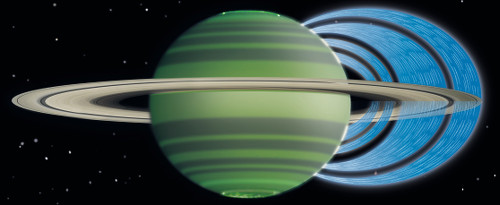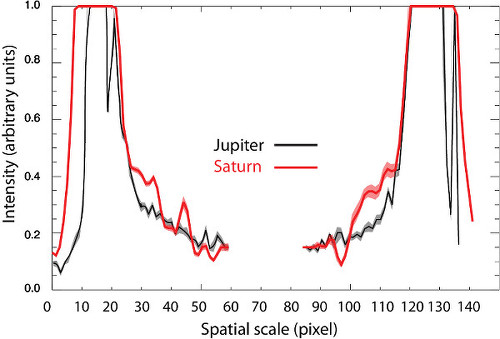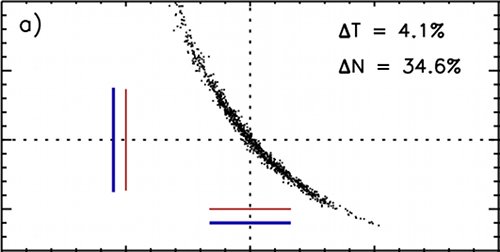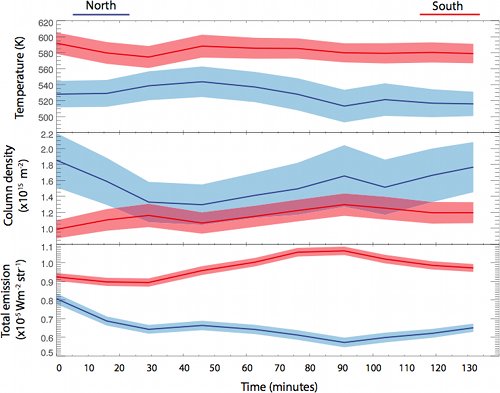 |
Publications with acknowledgements to this ISSI Team |
The domination of Saturn’s low latitude ionosphere by ring ‘rain’O'Donoghue et al. Nature 496, 193-195, (2013), doi: 10.1038/nature12049
During the first Team Stallard meeting, we concentrated on the comparison between Jupiter and other Gas Giants, especially Saturn, where the Cassini mission has provided a wealth of detail. However, the largest result of the first meeting came from the comparison of Ground-based data at Jupiter and Saturn. While Jupiter's equatorial region is relatively smooth, we found that for Saturn, there are significant variations in the ionospheric H3 The magnetic mapping of this variability, combined with the lack of any such features at Jupiter both directly point towards an origin for the variability in Saturn's rings. The most likely cause, described in the paper, is that ionised water is infalling from the Rings along magnetic field lines into the planet, where it then reacts with the planet chemically, removing H3 The discussions of the ISSI Team greatly aided both the interpretation of the results, as well as refocusing the Team onto the equatorial regions of Jupiter for the second meeting, a region largely ignored until recently.  |
On the anticorrelation between H3+ temperature and density in giant planet ionospheres.Melin et al. MNRAS 438, 1611-1617, (2013) doi: 10.1093/mnras/stt2299
During our discussions of the past papers and datasets that describe the joivian ionosphere, it became clear that most past work discussed an apparent anti-correlation between the H3+ temperature and density within the ionosphere.However, most of this work had a significant caveat attached, that this anti-correlation might be associated not with a physical process, but with the fitting procedures used. In this paper, Melin has produced a detailed assessment of the accuracy of the mot common fitting procedures used and has found that while anti-correlations do occur, the extent of this anti-correlation is entirely contained within the errors calculated for the fit. For the first time, this has shown that when an anti-correlation occurs within the data above the errors calculated, as has been found for both Jupiter and Saturn, this anti-correlation is real. |
Conjugate observations of Saturn's northern and southern H3+ auroraeO'Donoghue et al. Icarus 229, 214-220. (2014), doi: 10.1016/j.icarus.2013.11.009
Following the discovery and discussions surrounding the equatorial regions of Saturn and their relationship to Jupiter, we also identified a lack of understanding of how Saturn's auroral energy budget is controlled by H3+. At Jupiter, it is thought that the auroral regions are effectively cooled in direct response to auroral inputs. However, due to Jupiter having such small seasons, the effect of changing orbital inclination to the Sun is unknown for gas giants. These observations at Saturn showed an asymmetry between the North and South temperatures, which may have resulted from an inversely proportional relationship between the total thermospheric heating rate (Joule heating and ion drag) and magnetic field strength - i.e. the larger northern field strength leads to reduced total heating rate and a reduced temperature, irrespective of season. Such an effect should also be seen at Jupiter, so further analysis of Jupiter is underway to investigate this. |
Saturn Ring Rain: Water Influx into Saturn's AtmosphereMoore et al., Icarus (submitted) |
H3+ emission on the nightside of JupiterStallard et al., (with co-authors) |
Stability within Jupiter’s aurora ‘Swirl Region’ over moderate timescalesStallard et al., (with co-authors) |